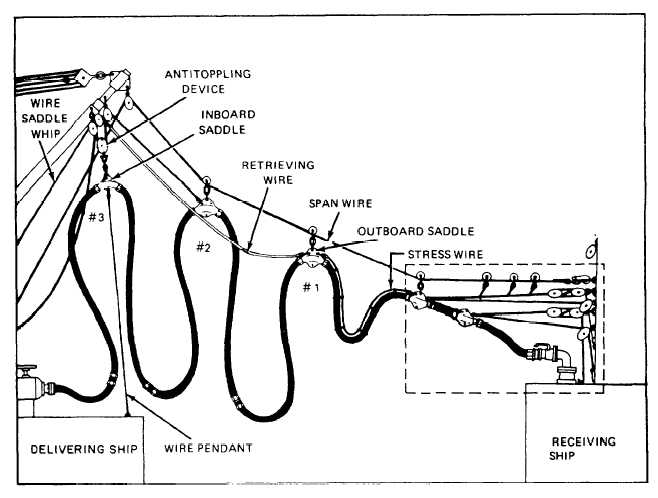| |
A complete set of working tools and repair
equipment must be maintained in a location that can be
readily accessed by transfer station personnel. Tools
and equipment should be inventoried and checked for
proper operation before each replenishment. Each
transfer station should maintain, as a part of station
equipment, a listing of all items (tools, spares, and so
forth) that may be required to repair the station, together
with the stowage location of such items.
REPLENISHMENT RIGS
LEARNING OBJECTIVE: Identify the
common replenishment at sea and fueling at
sea rigs.
Replenishment at sea is conducted by using a span
wire to support the fuel hose rig between the two ships.
The span-wire rig or close-in method may be used. The
method used is determined by the type of ship
delivering the fuel and the conditions under which the
delivery must be made. The main difference between
the rigs is in the method of extending the hose to the
receiving ship. Of the two, the span wire is preferred.
Ships not equipped to transfer by span wire must do
so by the close-in method.
SPAN-WIRE METHOD
In the span-wire method of fueling at sea, the hose
is carried between ships on a span wire that may be
tensioned or untensioned. The untensioned span wire,
normally is referred to as the conventional span-wire
rig. The tensioned span-wire method is referred to as
STREAM. STREAM rigs are rigged with four saddles
and a hose length of approximately 300 feet. The hose
hangs from trolley blocks that ride along the span wire.
Saddle whips position the hose while fueling, and serve
to retrieve the hose after the fueling operation is
completed.
The span-wire rig (see fig. 4-27) permits ships to
open out from 140 to 180 feet. Such distance is
reasonably safe and makes it fairly easy to maneuver
Figure 4-27.–Fuel stream, single hose with probe.
4-32
|

